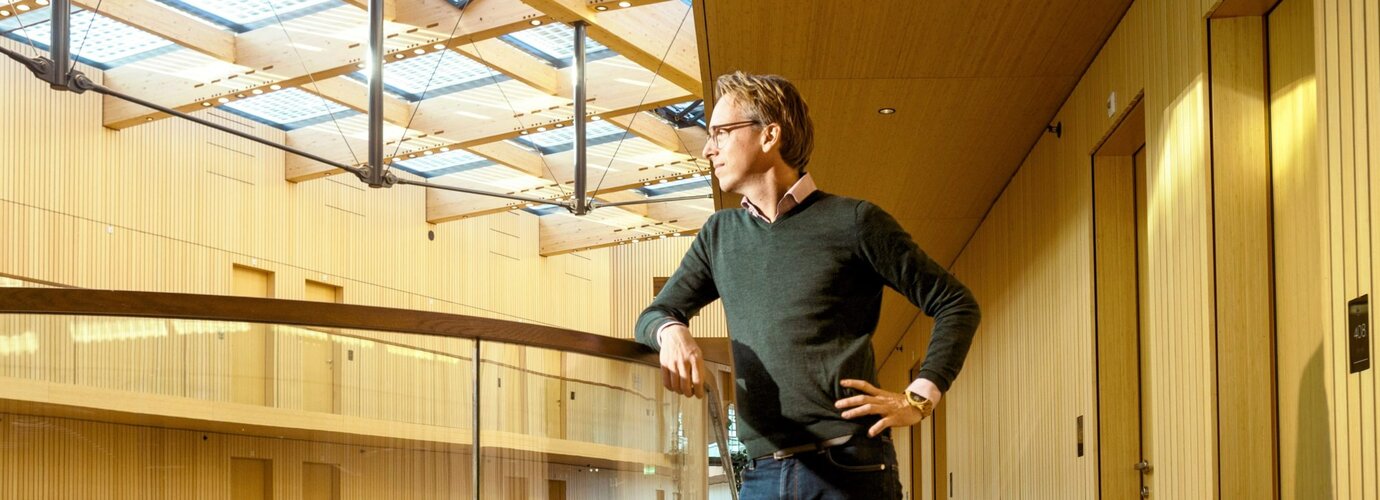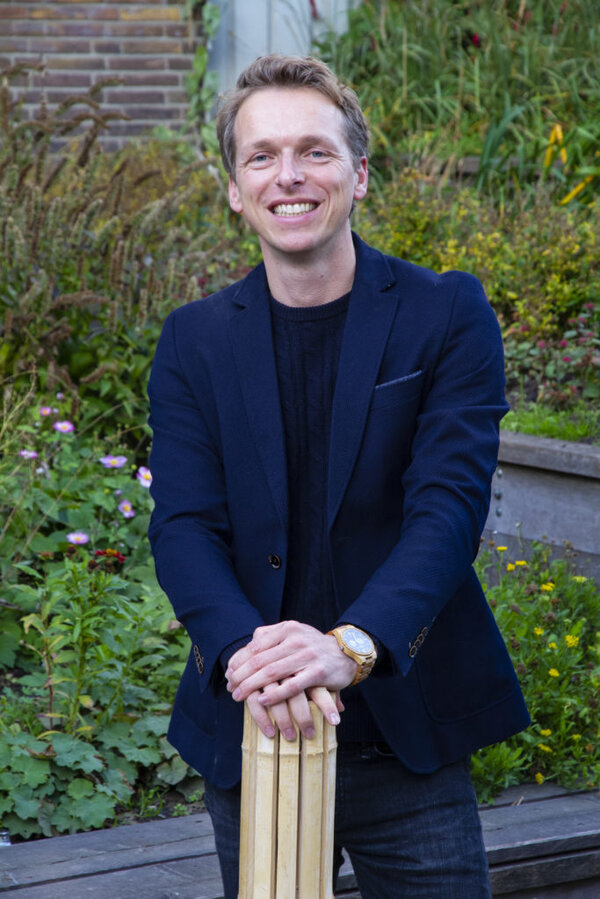05 April, 2022
Built by Nature announces Pablo van der Lugt as latest Board addition

Built by Nature announces Pablo van der Lugt as latest Board addition
Built by Nature is absolutely thrilled to announce the appointment of bio-based construction visionary Pablo van der Lugt to its Board of Directors. With his depth of expertise, passion and combined academic and industry profile, Pablo will add considerable momentum to the Built by Nature mission of accelerating the adoption of mass timber construction throughout Europe and in the U.K.
Based in the Netherlands, Pablo has held numerous leadership roles in the green building industry, provided several keynote speeches, and written several books and articles appearing in popular magazines and scientific journals – all to promote his cause of advancing the adoption of innovative bio-based materials and circular building systems.
Pablo’s vision is one of a fundamental transformation of construction towards circularity, especially through the ‘renewable route’, with huge potential and opportunities for bio-based materials including mass timber as sustainable alternatives to carbon intensive materials such as concrete, aluminum and steel.
To find out more about Pablo’s motivations, his views on the challenges and opportunities for mass-timber construction, Built by Nature posed this series of questions to our newest Board member:
Built by Nature: How would you describe the current state of affairs around the adoption of mass timber in construction?
Pablo van der Lugt: We are in a unique moment in time which sets the stage for a potential major shift towards mass timber construction is eminent – the climate crisis, housing deficit, and latest advancements in mass timber building construction system based on increased digitalization and robotic manufacturing, set the right preconditions for a mass timber building revolution.
Although the percentage of mass timber buildings in various Western European countries is still relatively low, there are clear signs that this is rapidly changing with several countries and urban areas ramping up their timber building ambitions to meet their climate and circularity ambitions. For example, the Metropolitan Region of Amsterdam has committed to 20% timber use in new residential buildings by 2025, which is a major increase from the 2-3% the urban region is now at. The ambition is to grow further to about 50% in 2030. Built by Nature can help accelerate and manifest this ambition in Amsterdam, but also other major urban regions across Europe.
What are the perception barriers that we need to overcome?
I am still amazed by the many misconceptions and prejudices about timber building, many people still think tropical deforestation is linked to timber use (while this is caused by large scale agriculture, conversion to cattle land and mining), that timber houses are not durable and not fire safe, and it is predominantly bad to cut a tree. People have no idea that mass timber in Europe comes from sustainably managed production forests, mostly with FSC and PEFC certification, safeguarding the forest and biodiversity remains intact, which increase by 500.000 soccer fields each year, and still have a lot of additional capacity, but do not ask themselves where materials such as bricks, concrete and steel come from – these don’t grow back and their production is associated with high amounts of CO2 emissions.
In contrast, CO2 extensive mass timber products such as CLT and glulam store about 10 times more CO2 than is emitted during production (including the transport, manufacturing and the 1% glue content in the products).
To dispel these myths we need a mass media campaign to reach the larger professional audience, like the popular scientific documentary ‘Tegenlicht’ about the potential of mass timber buildings. I am convinced we need more of these documentaries to reach decision makers across Europe about mass timber building. Myself… I have tried to dispel some of these misconceptions and explain the true potential of mass timber building through my publications, peer-reviewed reports and presentations.
Which markets do you see leading the way and what can we learn from them?
We can learn a lot from Scandinavian countries which have successfully developed a timber building culture, promoting its use, leading to high percentages of timber buildings up to 20-30% of the total volume. Further I see a lot of momentum in the Dutch and UK market, with a lot of interest in increasing the amount of mass timber buildings to meet climate and circularity goals, but also the perceived health effects – timber buildings provide a very pleasant indoor climate and also an increasing body of research has revealed that the visual application of natural materials including timber in a building can lower stress levels and increases well-being through biophilic design. In these markets we also see specialized modular housing factories in timber popping up, which produce modular, circular homes in a very high quality and with very low construction times with far less nuisance (noise, but also CO2 and NOx emissions) for surroundings.
What national policy frameworks do you think need to be in place?
We need a level playing field in each country for timber building – which often means that building codes and regulations which disadvantage light building methods such as mass timber building, need to be adapted. For example, throughout Europe the stored carbon in mass timber products the so-called Construction Stored Carbon is not accounted for in the required Environmental Product Declaration which determine the environmental impact, claiming the CO2 is emitted again during end-of-life. However, if constructed well, the lifespan of mass timber buildings is far longer than the IPCC horizon of 100 years, and mass timber can be easily reused -- the elements will not be burnt as they simply constitute too much value--, storing the CO2 for even longer. We see the same on other levels, relating to energy requirements for Paris Proof – CO2 neutral buildings being based on heavy materials with high thermal mass instead of the lighter timber buildings which require different ventilation methods sometimes not fitting in traditional building codes.
Once governments and the European Commission further acknowledge the combined potential for sustainable forestry and timber buildings as two constructive vehicles to mitigate climate change and increase circularity, the right policies can be implemented to stimulate, instead of hamper, mass timber construction.
The construction industry is seen as somewhat conservative and traditional – what narratives would you use to “shake things up”… is climate change enough?
We need to turn things around, first get rid of the many misconceptions about mass timber building, and then show that mass timber buildings are actually incredibly pleasant to live in, better for health, better for the environment but very beautiful and stylish as well – providing new design possibilities. A mass timber building can be extremely modern and high end.
So we need to show that mass timber building is not only a climate solution, it is also healthy, cool and sexy, in a similar way as electric cars image has shifted from being left-wing / high end to mainstream, the same need to happen with mass timber buildings, and it will. But for this we need keep informing the audience through smart, targeted communication campaigns -- design competitions, demonstrations, documentaries -- reaching the right target groups.
What is it about Built by Nature that led you to join our Board?

The incredible high ambition and professionalism of the Laudes foundation wanting to really make a difference and driving the mass timber agenda, not for the sake of mass timber, but because it is a very viable route to help meet our sustainability goals. I believe that through the power, reach and ambition of the BbN organization headquartered in Amsterdam, and its Accelerator fund, the mass timber revolution will actually happen, and faster than we had ever anticipated. This will set an example for other continents, with large forestry resources, to start managing these sources better, and converting them not for short term usage, but to high value-added building products, shaping healthy, carbon neutral cities of the future.
I am honoured that through the BbN Board I can assist in making this hard-needed vision manifest.
NOTE: In responding to our questions, Pablo provided several reference and research sources, listed here:
https://www.vpro.nl/programmas/tegenlicht/kijk/afleveringen/2019-2020/houtbouwers.
https://www.ams-institute.org/news/signed-and-sealed-green-deal-timber-construction/
With support from Delft University of Technology and AMS Institute, Pablo has written a peer-reviewed report dispelling the major mass timber myths:
https://www.ams-institute.org/documents/64/AMS_Institute_Houtbouwmythes_ontkracht.pdf.
Header photo by Eran Oppenheimer
